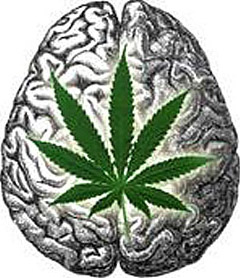Mind Control, PTSD, and the Effects of Repressed Memory on Mind/Brain Function
By Shaela Miller
July, 2015 ©
As someone with a personal family history of both psychological and neurological disorders, I have gained a deep passion for understanding normal/abnormal behavioral psychology, neuro-sciences, recovery from PTSD (Post Traumatic Stress Disorder) and the effects of trauma on mind/brain function. Recent press involving Mr. Hugh Hefner of Playboy Enterprises regarding the release of former girlfriend Holly Madison's highly publicized book1 on life at the Playboy mansion has presented the ideal opportunity to comprehensively discuss the catch all phrase "mind control." This article is intended to address the difference between robotic mind control, common symptoms of mental disorders that occur from repressed memory related to trauma, and normal human behavior.
 Mind control is a vast subject ranging from basic social behavior influenced by peers to the robotic type mind control that causes an individual to suicide without question for religious purposes. The mind/brain function is fascinating in that it protects one from trauma too horrible to comprehend. Whether it be childhood sexual abuse, witnessing a significant traumatic event, or being forced to kill another human being in combat (which is against innate human nature), the brain will physically compartmentalize or store the memory in a secluded part of the brain which causes neurological disturbances and mild brainwave abnormalities that can be visible under adequate medical equipment.2
Mind control is a vast subject ranging from basic social behavior influenced by peers to the robotic type mind control that causes an individual to suicide without question for religious purposes. The mind/brain function is fascinating in that it protects one from trauma too horrible to comprehend. Whether it be childhood sexual abuse, witnessing a significant traumatic event, or being forced to kill another human being in combat (which is against innate human nature), the brain will physically compartmentalize or store the memory in a secluded part of the brain which causes neurological disturbances and mild brainwave abnormalities that can be visible under adequate medical equipment.2
Such compartmentalization ultimately decreases the firing frequency of the neuron pathways in the brain in order to allow the individual to function day to day without having to face/relive the event. This is viewed as a normal, sane behavior set in place through generations of evolution in order for the human race to survive.
Far too common, children are subjected to these types of incomprehensible situations and thus are forced to repress the memory until their personality has fully developed in later years. Once the personality has finished developing, the brain prepares to access those memories through hormone and/or electro-chemical changes to regain full access to the brain between the ages of 27 to 35 which can have a detrimental effect on the individual's ability to live normally if not properly addressed. This is undeniably evidenced by the reported numerous actors, actresses and musicians in this approximate age group4 who experience this condition.

Trauma can cause dissociation in children and adults, making the individual appear as though they are day dreaming, or they can experience a loss of time or loss of days as they desperately try to escape their own mind. The result is escaping reality instead, thus worsening the condition. The severity of the condition may vary according to the significance of the trauma, how often the events occurred, and how the event was perceived/experienced.5
When a person is subjected to traumatic events repeatedly through their life, the brain creates numerous compartments to accommodate the multiple events, shattering the individual's perception of self as the mind has become disjointed with less and less neuron firing. This is known clinically as DID, or “Dissociative Identity Disorder”.6 Often this disorder is expressed (more often than not with the help of poor therapy) through created alter egos, stage names, or naming of the personalities, which greatly impedes the healing effort. An example of this was documented in the book published by Playboy Press in 1976 titled The Control of Candy Jones by author Donald Bain.7
With minimal yet significant repetitive trauma, or incredible childhood neglect, the individual will sometimes create a fantasy whereby they become someone else,8 such as a Disney princess or famous icon they admire, in order to separate from their real identity and protect the self from the  repressed memory and/or trauma. This is why so many actors/actresses excel at playing roles because in their mind, they really are the person they are pretending to be. Some actors/actresses will even get stuck in a role and cannot get out of character, so to speak, and temporarily lose their ability to play any other character. Such an example of this was reported in November 2012 by The Whiskey Journal when actor Daniel Day Lewis was committed to a mental health facility after playing the lead role of a former US President in the historic drama Lincoln.9
repressed memory and/or trauma. This is why so many actors/actresses excel at playing roles because in their mind, they really are the person they are pretending to be. Some actors/actresses will even get stuck in a role and cannot get out of character, so to speak, and temporarily lose their ability to play any other character. Such an example of this was reported in November 2012 by The Whiskey Journal when actor Daniel Day Lewis was committed to a mental health facility after playing the lead role of a former US President in the historic drama Lincoln.9
The worst types of traumas result in the appearance of an individual's not “being present” causing them to appear ditsy, stupid, or blissfully off in “lala” land. These individuals are very literal in their language and responses. A good example is the well-known joke by Jessica Simpson on an ad where she states “I didn't know buffalos had wings.” Though this was only an ad, it is reflective of the behavior of individuals in this highly suggestible state of mind. This type of behavior became a common social standard10 in the 1980s and was seen in society in general during this time. Even intelligent women would put on this act of being "stupid" in order to maintain social standing as portrayed by Goldie Hawn, Cyndi Lauper and the well-known persona of the Valley Girl.

Often, traumatic events involve physical pain which affects the firing of pain receptors in the brain, often diminishing in the individual's ability to feel much of anything, including pleasure.11 If the trauma is significant enough, it can prevent the individual's being able to see themselves in a mirror, which is clinically referred to as Depersonalization Disorder or DD.
An example of DD is people who inflict self-mutilation, such as cutting, etc. in an attempt to feel something. This shattered perception of self is also reflected in people who feel a need to surgically enhance themselves in a way that they can perceive in order to identify with themselves as real physical objects (clinically referred to as “Body Dysmorphic Disorder” or BDD12 which is one of the many levels of DID). These individuals often attempt to draw attention to themselves - by any means necessary.13 They are subconsciously seeking a savior or escape from their trauma, even if they are no longer in danger at the time.14

One sign of repressed childhood sexual memory in women is their displayed heightened sexuality or high sex drive. Often these women are drawn to businesses reflective of high sexuality because that is all they have ever known. “Pimps” or abusers on the streets being aware of this can easily take advantage of these individuals by providing highly addictive drugs and then supplying the women to buyers as prostitutes. This rewards the abuser and prevents the prostitute from gaining financial independence. This limitation of finance and heavy addiction is ultimately where mind control comes into play as it creates a form of Stockholm syndrome where the abuser is the holder of their basic survival needs such as food, clothing, housing and the perceived need caused by the intense drug addiction.
There are significant differences in Mr. Hefner's case from that of a street abuser since the use of addictive drugs and prostitution is grounds for termination were his associates to participate in these acts while involved with Playboy.15

Normal life: Holly posted a photo on Instagram in July 2013 showing her on a tarmac in butterfly dress and a male companion, presumably Pasquale Rotella, in a yellow bear mask. The photo caption read: "I love my normal life!"
There are many key points that clearly show why Ms. Madison's claims of “control” and “manipulation” are faulty and instead suggest the environment provided by Mr. Hefner could potentially provide the ideal situation for the healing process to begin. Here is why: Individuals experiencing “loss of time” resulting from dissociative disorders, by following a schedule will force the brain to have a conscious concept of time, inevitably causing the brain to begin firing. The Playboy mansion life style provides a safe and structured environment in which women with varying levels of dissociative disorders are free to express their high sexuality while all their basic living needs are being met. This includes an opportunity to gain financial independence that could result in iconic fame as evidenced by Playmates Pamela Anderson and Anna Nicole Smith.
Mr. Hefner has created a concept for these women to gain self-worth, which is another requirement for healing. Playboy magazine is unique in that it promotes a playmate of the month who exhibits intelligence and independence, portraying the image of “the girl next door.” Having the opportunity to gain self-worth, these women are then inspired and driven to give themselves a better life. Playmates notoriously end up married to super stars, high ranking sports players, or become icons themselves.
By my perception, this is ultimately what another former girlfriend of Mr. Hefner's, Kendra Wilkinson, has publicly referred to when she stated “Hef saved my life.”16 Not only did he save her life, he saved her mind and future as clearly reflected by her current fame.17
 Holly Madison (a.k.a. Holly Cullen before her self-imposed, pre Playboy stage name) is an ideal example on which to base this article as she reflects many of the symptoms stated above. However, due to the exceptional creativity she displays in the Girls Next Door reality TV series featuring her creative talent for photo editing/directing,18 her suggestions that Mr. Hefner is a “controlling manipulator” or “Svengali”19 is a classic example of side effects that may occur when attempting to help an individual in this state of mind who hasn't had adequate therapy.
Holly Madison (a.k.a. Holly Cullen before her self-imposed, pre Playboy stage name) is an ideal example on which to base this article as she reflects many of the symptoms stated above. However, due to the exceptional creativity she displays in the Girls Next Door reality TV series featuring her creative talent for photo editing/directing,18 her suggestions that Mr. Hefner is a “controlling manipulator” or “Svengali”19 is a classic example of side effects that may occur when attempting to help an individual in this state of mind who hasn't had adequate therapy.
Creative thinking causes the brain to exercise. This forces the brain to start firing, causing repressed memory to surface whether the individual wants to remember or not. Were mind control a factor at the Playboy mansion, Holly would have been unable to perform these complicated, creative tasks or project the lovable, clearly intelligent woman we all adored on the reality series that aired for five seasons.
Ms. Holly states in her book “Maybe it was the pot and alcohol” when contemplating suicide at the Playboy mansion.20 Alcohol can cause this effect,21 however, marijuana has been clinically proven in worldwide studies to have the opposite effect on these types of ideations in addition to having positive medical benefits on mind/brain function. Dr. Sanjay Gupta's three part series documentary WEED presented by CNN in the spring of 201522 comprehensively supports this and the following medical statements regarding the herb.

Marijuana, by its very nature has been the highest rated and most successful coping tool for soldiers who are suffering from PTSD as the THC (Tetrahydrocannabinol - a psychoactive component of the marijuana plant) in the herb tricks the brain into believing it feels good which can ultimately make all the difference in surviving the physical pain caused by the intrusive memory or flash backs surfacing. By affecting the firing in the brain, this herb takes the user into the now, which slows the mind/brain from aggressively reliving flash backs or intrusive memory.
Medical marijuana has also been proven to physically heal the brain.23 Clinical studies have shown that among those who have suffered brain injury (whether it be from epilepsy, stroke or physical trauma) the damage was reduced in those subjects that had used cannabinoid therapies as opposed to those that had not. Studies have also shown that marijuana slows down the deterioration of the brain in individuals who suffer from Alzheimer disease.24
There are certain nutrients required for proper brain function, such as calcium,25 sodium,26 and magnesium.27 The brain has what are called cannabinoid receptors that are affected by these nutrients. CBD are diverse marijuana chemical compounds that act on cannabinoid receptors on cells that repress neurotransmitter release in the brain. When the CBD are introduced into the traumatized mind, whether through smoke, edibles or oil, they affect these receptors causing more normal conductivity which creates fluidity of brain function by repressing the frantic neurotransmitters caused by the repressed memory surfacing.28 This will inevitably cause the brain to access the memory in a way that can be controlled logically rather than having to emotionally relive the event.
Chemically induced fluidity of conductivity within the brain can prevent a soldier from engaging in the 'point and shoot' survival behavior required in combat and is why the herb is thought to be banned and it's use highly reprimanded within the US military. It is claimed that this is why marijuana was so readily available to US soldiers during the Vietnam War, as it reduced their ability to follow training/orders and resulted in our losing the war is intended by the Vietnamese war captains who knew this.29
The mind/brain is genetically wired for survival of the human race as a whole. It is natural to hesitate prior to firing/killing of another human being unless otherwise methodically trained to do so without thought.30 This is why our military is taught to “just do it” because otherwise they would not be able to perform such as emotional task of killing. The very act of going against human nature will cause PTSD even if the event was for the purpose of survival. When the memory flashes are properly addressed, medical marijuana can be a vital tool for coping and ultimately result in full brain function with adequate therapy.

When in a safe environment and the intrusive memory is not addressed properly the side effects include: depression, suicidal ideations, feelings of worthlessness, self-doubt/self-hate, heightened sexuality or high sex drive, excessive self-focus, flip flop in projected behavior (similar behavior to that of the story of Dr. Jekyll and Mr. Hyde), impulsive aggressive communication and 'fight or flight' response31 to escape the intrusive memory, which is impossible. The individual is left with negative feelings towards the very one that offers help since it is safer to blame the savior rather than the original abuser as this would mean having to face the repressed memory in order to do so. They will most likely run to the original abuser (or someone like the original abuser) in a desperate attempt to remember their repressed memory. The subconscious mind does not have the ability to logically reason and thus will run to the closest reminder, which in turn pushes the memory that much further back into the compartment to subconsciously protect the individual from the abuse they are having to face yet again. The repressed memory will then attempt to resurface again, though far more aggressively, much later in life.32
This is thought to account for the high incidence of re-enlistment among soldiers returning from combat. Now forced to face the reality of the horrors of war with no therapy or guidance and the threat of losing all government benefits for their families and loved ones if they ask for help, suicide has become a common solution.
In cases of the Iraqi and Afghan wars, data shows that the US has lost more soldiers to suicide after returning home than we have in combat since the wars began. Averaging 22 suicides per day,33 which is approximately 8000 a year, or 80,000 people in the last 10 years. These individuals who gave so much are part of the inspiration for this article.
Healing is possible. Every level of PTSD is worth addressing, no matter how big or small. You cannot judge a person for where they have been, you can only hold them responsible for what they do with it now.
About the Author: Shaela Miller, age 27.
From child to young adulthood, she was exposed to both the best and worst of the Mormon and occult based religions. In addition to her exposure to these ritualistic organizations, she has a family heritage of both psychological and psychiatric disorders. The combination has set her on a life path for establishing a scientific based foundation on mind/brain function. As a spiritual, yet none religious person, the information she provides does not require faith to be acceptable. This article is a conglomeration of some of the truths she has gained in her studies for understanding.
- Holly Madison, Down The Rabbit Hole: Curious Adventures And Cautionary Tales Of A Former Playboy Bunny DEY St. June 2015
- Martin H Teicher MD, PHD, Wounds That Won't Heal: The Neurobiology of Child Abuse 2000
- DSM V Section II Diagnostic Criteria & Codes, Chapter: Dissociative Disorders
- Britney Spears, Lindsay Lohan, Amanda Bynes
- Colin A Ross, MD, The Osiris Complex
- The International Society Of Dissociation
- ISBN 87223-457-6
- William S Kroger MD, Clinical and Experimental Hypnosis Second Edition
- http://www.thewhiskeyjournal.com/36284223267/
- James C. Colemen, Abnormal Psychology And Modern Life 5th Edition University of California Las Angeles
- Beecher HK Ann Surg., Pain in Men Wounded in Battle
- BDDfoundation.org
- Id DSM V
- Id Dr. Colin A Ross, MD, The Osiris Complex
- Id Holly Madison, Down The Rabbit Hole 97
- Girls Next Door Reality TV Series, Season 1
- Kendra On Top 2014 & Marriage Boot Camp 2015 WeTv
- Girls Next Door Reality Series Season 5
- US Magazine June 10, 2015
- Id Holly Madison, Down The Rabbit Hole 5
- com http://alcoholrehab.com/alcoholism/binge-drinking-increases-suicide-risk/
- Weed 1: https://www.youtube.com/watch?v=Z3IMfIQ_K6U https://www.youtube.com/watch?v=i2qFDb8LExo https://www.youtube.com/watch?v=Z3IMfIQ_K6U
- Journal of Cerebral Blood Flow & Metabolism in December 2014,
- com http://alzheimers-disease.yoexpert.com/treatment-options-9160/coping-with-celiac-diseasey-to-stay-fit-always-2160.html
- Dan Moran, Ph.D., Calcium's effects on Brain Function April 2007 http://www.prevagen.com
- A new role for sodium in the brain Science Daily Aug 30 2013 McGill University http://www.sciencedaily.com/releases/2013/08/130820113931.htm
- Magnesium Boosts Brain Function Saturday, September 15, 2012 Byron J. Richards, Board Certified Clinical Nutritionist
- Marijuana and your memorycom Health Oct. 21 2014 http://www.leafscience.com/2014/10/21/marijuana-memory/
- Art Of War two hour special History Channel 2009
- “Behavioral Psychology” The Problem: Resistance To Killing 1999 By Academic Press.
- Id DSMV: Chapter On Obsessive Compulsive Disorder
- Sari Tudiver, Ph.D, Lynn McClure, N.P., Tuula Heinonen, Ph.D., Christine Kreklewitz, M.A., and Carol Scurfield, M.D, Remembrance of Things Past: the legacy of childhood sexual abuse in midlife women Canadian Woman's Health Network 2012 http://www.cwhn.ca/en/node/41877
- Armed Forces Foundation 2015




